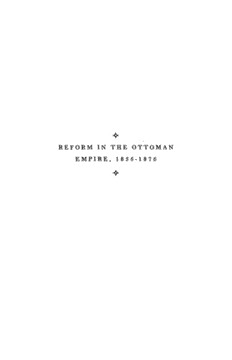
Reform in the Ottoman Empire, 1856-1876 PDF
Preview Reform in the Ottoman Empire, 1856-1876
REFORM IN THE OTTOMAN EMPIRE, 1856-1876 REFORM IN THE OTTOMAN EMPIRE 1856-1876 By RODERIC H. DAVISON PRINCETON, NEW JERSEY PRINCETON UNIVERSITY PRESS I963 Copyright © 1963 by Princeton University Press ALL RIGHTS RESERVED L.C. Card: 63-12669 + Printed in the United States of America by Princeton University Press, Princeton, New Jersey For Louise and John and Richard £^E PREFACE S^S The study of the Tanzimat period—that crucial time of attempted reform and westernization in the nineteenth-century Ottoman Empire —is still in its infancy. We are many years and scores of monographs away from a definitive history, which will be possible only after full exploitation of the Turkish archives and of other widely scattered materials in over a dozen languages. Much still remains to be known simply of what happened and how and when, not to speak of why. This, therefore, is a preliminary attempt to recount and assess the major reform developments and to put them in their historical con text. The focal period is the climactic two decades of the Tanzimat which led up to the promulgation of the first Ottoman constitution in 1876. Social scientists interested in the impact of the West on a nonwest- ern area may find points of useful comparison in this analysis of the later Tanzimat period. It deals in large measure with westernization, particularly in the political sphere, and may be considered to bear also on the even more slippery concept of modernization. Yet I am re luctant to call this a case study. I have attempted no comparisons with other areas where the political and cultural impact of the West has been strong. There are parallels to be drawn, but also sharp con trasts. And as will, I hope, be obvious to the reader, individual per sonalities and the pure concatenation of historical events exercised a major influence on efforts made in this period to reform and revitalize the Ottoman Empire. The genesis of the constitution of 1876, for example, is otherwise inexplicable. It can be asserted with more con fidence that this essay in a key period of modern Turkish history will provide some of the background necessary to an understanding of later reform efforts and of aspects of the growth of the Turkish Republic. I have tried, however, not to focus only on those developments which adumbrate the emergence of the modern Turkish nation, but rather to look at the problems of the vast and heterogeneous Ottoman Em pire as it then was. My debt to the contemporaries who recorded events and currents of that time, and to modern scholars who have dug back into various aspects of the Tanzimat, will be evident on almost every page. I am further indebted to the many scholars who have given me suggestions vii PREFACE on one point or another, or help in locating materials. Among them are William L. Langer, with whose encouragement this study was begun, Haul Inalcik, Lewis V. Thomas, Niyazi Berkes, George C. Miles, Aydin Sayili, Seving Diblan Carlson, Stanford Shaw, and the late Michael Karpovich and Chester W. Clark. I am also grateful to four others, now gone from us, who many years ago read critically parts or all of the original dissertation from which this book took its start: Abdiilhak Adnan-Adivar, J. Kingsley Birge, Walter L. Wright, Jr., and Daniel C. Dennett, Jr. Dankwart Rustow furnished very help ful criticism at a later stage. Three other friends—A. O. Sarkissian, Jakob Saper, and Elie Salem—have helped me to use materials in Armenian, Polish, and Arabic. My brother, W. Phillips Davison, as sisted me in using materials in the Scandinavian languages, and also copied some documents in the Swedish archives. Howard A. Reed, Robert Devereux, and Albertine Jwaideh kindly allowed me to con sult their unpublished dissertations. The staffs of many libraries have been very helpful. Among them are the Harvard College Library, the Princeton University Library, the New York Public Library, the Library of Congress, the British Museum, the Bibliotheque Nationale, the Centralbibliothek in Zurich, the George Washington University Library, the State Department Library, and the Middle East Institute Library. I have received many courtesies also from the staffs of the Public Record Office in London, the Archives des Affaires Etrangeres in Paris, the Haus- Hof- und Staatsarchiv in Vienna, and the National Archives in Washington. The American Board of Commissioners for Foreign Missions gen erously granted permission for use of their manuscript records. In its initial stages the work was made possible by a fellowship from the Social Science Research Council. I am also much indebted to Sir Hamilton Gibb, Derwood Lockard, and others of the Center for Middle Eastern Studies at Harvard who in the spring of i960 pro vided a research fellowship that greatly helped to bring this study along toward completion. At the same time, a light teaching load was kindly arranged by Robert Lee Wolff and Myron P. Gilmore of Harvard's History Department. The Committee on Research of the George Washington University has also given assistance. On several occasions Nancy Hull Keiser, of the Keiser Foundation, and the Middle East Institute have provided a haven for research and writ- viii PREFACE ing. Carolyn Cross, Brenda Sens, and Bonnie Pugh did meticulous typing. Miriam Brokaw and Mary Tozer have provided sound edi torial advice. What I owe to my wife and sons for their tolerance for research cannot adequately be expressed. The book is dedicated to them. Washington August, 1962 R. H. D.
